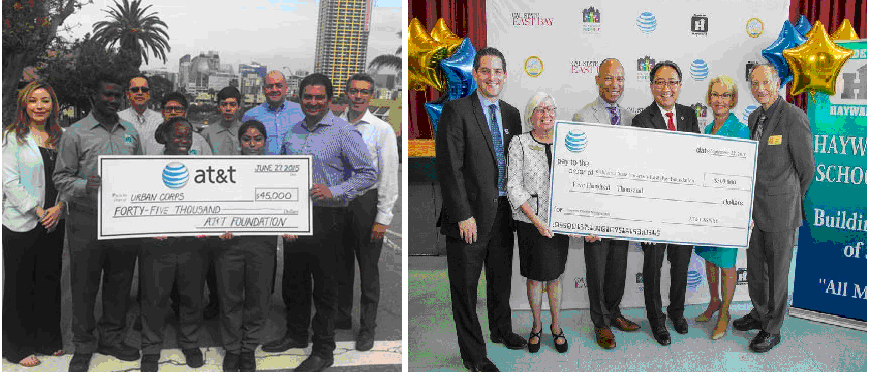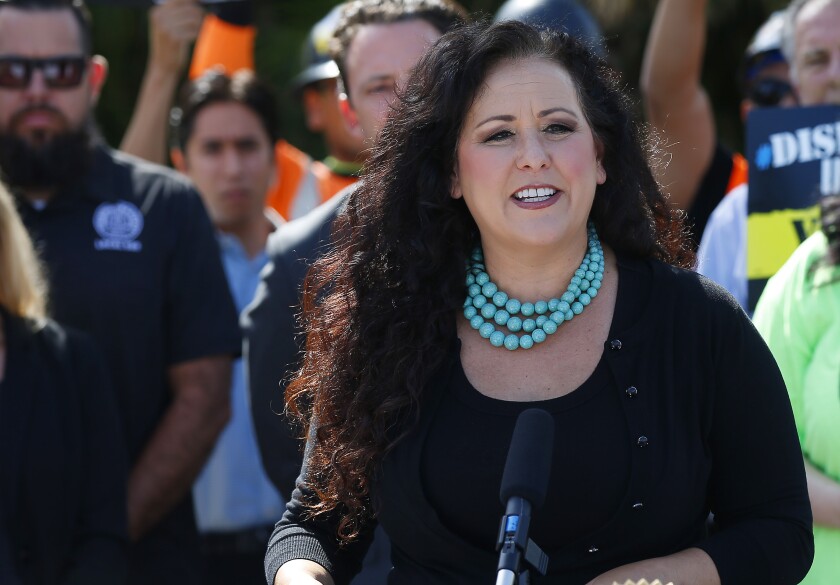Adapted from an article by Bruce Kushnick, Sept 20, 2021 | Original Medium article here.
California needs investigations into the $Billions of cross-subsidies carried out by AT&T Holding Co. to avoid paying California State taxes and boost its corporate profits. For decades, Big AT&T has transferred $Billions from its REGULATED wired State PUblic telecommunications Utility Co. (AT&T-California) to its UNREGULATED wireless subsidiary companies (New Cingular, AT&T Mobility, and others). These financial sleights-of-hand have been and continue to be in direct violation of the 1996 Telecommunications Act: Title 47, §254(k), which states:
§254(k) Subsidy of competitive services prohibited
“A telecommunications carrier may not use services that are not competitive to subsidize services that are subject to competition. The Commission, with respect to interstate services, and the States, with respect to intrastate services, shall establish any necessary cost allocation rules, accounting safeguards, and guidelines to ensure that services included in the definition of universal service bear no more than a reasonable share of the joint and common costs of facilities used to provide those services.
These misallocated $Billions by AT&T Holding Co. were originally earmarked to fund a fiber optic future for California. The State doesn’t need these three corporate-sponsored wireless bills — all three bills deserve a veto by Gov. Newsom in order to preserve local control over the placement and construction of Wireless Telecommunications Facilities (WTFs):
- SB.556 (Dodd): the “Destroy Local Control & Child Endangerment” Wireless Bill
- AB.537 (Quirk): the “Deemed Approved, Deemed Permit-Issued” Wireless Bill
- SB.378 (Gonzalez): the “Cheap Micro-Trenching & No Public Access to Fiber” Bill
The three bills were written for the wireless industry with the help of what appears to be ALEC, the American Legislative Exchange Council — and simply handed to CA’s State Legislators.
As we will discuss, AT&T et al. created the Digital Divide and they now want to remove the remaining regulations and obligations, and, of course, increase their profits rather than serve its customers with high-speed broadband and internet and compete for customers, which would lead to lower monthly bills.
At the same time, Congress and various state and federal agencies are gearing up to give these companies government subsidies, rewarding them even though they left a trail of broken broadband promises.
Link to: The Rise and Fall of Fiber Optic Broadband in San Diego, a city which had a ‘landmark’ agreement to have the entire region upgraded, starting in 1997, and completed, even in ‘unserved areas’, by 2010. San Diego, unfortunately, has nothing to show for this agreement. AT&T never delivered and was never held accountable.
We estimate that there has been $1.7-$2.4 billion annually in potential overcharges to AT&T-California’s Local Service — the copper, switched Plain Old Telephone Service (POTS). This money should have been spent to upgrade that copper to the fiber optics to the premises (FTTP) — all the way to every home and business.
Four years ago,we wrote about SB.649, an earlier Wireless Telecom bill designed to eliminate the rights of cities, but also used to justify not upgrading the existing state’s wireline telecommunications infrastructure. Fortunately, Gov. Jerry Brown vetoed that bill, writing:
“I believe that the interest which localities have in managing rights of way requires a more balanced solution than the one achieved in this bill.”
In our article from 2017, we focused on those who pushed these bills through the CA Legislature:

Caption: On the left, Senator Ben Hueso, (Chairman of the Standing Committee on Energy, Utilities and Communications) & AT&T present a $45,000 Grant to Urban Corps of San Diego County, his district. On the right, the principal coauthor of AB 537, Assembly Member Quirk getting a ½ million dollar check for a project in his area from AT&T.
The bills, draped in the language of public good — and purporting to bridge the Digital Divide, appears to have been a ruse. We previously wrote:
“California Wireless Legislation: Paid for by AT&T Et Al. 05/15/2017, Huffington Post.
“There is a proposed piece of legislation in California for the deployment of lots of so-called 4G/5G “small” wireless facilities — a streamlining plan being pushed in other states, the US Congress and at the FCC. And, wouldn’t you know it; those who benefit the most from these state and federal gifts are AT&T et al., the companies who are also funding and engineering these campaigns. In fact, these state bills appear to be based on ‘model legislation’ that was created by the Wireless Infrastructure Association, WIA and by ALEC, the American Legislative Exchange Council. “
The Wireless Industry has Never been a Friend of California Cities
During your time as Mayor of San Francisco, you were involved in a lawsuit that was initiated by the CTIA, the wireless trade association, (with one of the lawyers having been the now-FCC Commissioner Brendan Carr). And in this case, the CTIA claimed that their First Amendment rights had been violated.
At the time, as Mayor of San Francisco, you wrote:
“I am surprised that industry representatives would choose to spend untold sums of money to fight this in the courts, instead of cooperatively working with San Francisco to comply with a reasonable law that provides greater transparency and information without putting any undue burdens on small businesses or discourage cell phone use in any way.”
Does the Governor now believe that these companies are going to act in California’s best interest or more importantly, that cities should lose their rights to determine the future of the locality’s technology?
These three 2021 Telecom (SB.556, AB.537 and SB.378) are just SB.649 all over again, but split across three bills to attempt to outrun strong opposition to these bills. The bills are attempting to exploit the current problem Digital Divide — a problem created by the Telecoms on purpose. It took a pandemic to stir up public outrage over the lack of competition for high-speed broadband service and the Telecom companies’ decisions to allow whole areas of the state to deteriorate, especially rural areas and low income urban areas.
The Densified 4G/5G Agenda Has Been an Industry Embarrassment.
Densified 4G/5G requires a fiber optic wire to connect each so-called “small” Wireless Telecommunications Facilities (sWTF) to the Internet. The new wireless service has not performed as advertised. Actual, current 5G speeds (25-30 Mbps down, 5-6 Mbps up) can’t compete with a fiber optics to the premises (FTTP), which has symmetric service (1,000 Mbps down, 1,000 Mbps).
Through institutional amnesia, it seems no one knows that AT&T California (sometimes called “Pac Bell”) is still a State Public Telecom Utility (SPTU), that was supposed to have completed state upgrades from copper to fiber optics. Customers paid billions from increased rates on their phone bills to make this happen — but AT&T didn’t deliver. The holding company just pocketed the increased revenues.


In 1993, Pacific Bell stated it would replace the existing copper wires for fiber optic services, and by the year 2000 they would spend $16 billion and have 5.5 million households upgraded. This page, from the 1994 Investor Fact Book, lays out the areas that were supposed to be upgraded.
Click for a history of failed fiber optic broadband deployments by AT&T-Pac Bell, (through 2006).
And they used the fiber optic promise to do a bait-and-switch to get rid of regulations and get more profits with “price caps”. Pac Bell started this upgrade process in 1989 with the claim that another technology delivered over copper, ISDN, was needed. (ISDN came to be known as “It Still Does Nothing”.)
When SBC merged with Pac Bell in 1996, it closed almost everything that was being built, didn’t spend the $16 billion and was never held accountable.
Move up a decade, and AT&T announces U-Verse, which the company claimed would be fiber to the home. It was used by former FCC Chairman Michael Powell, (now chairman of the NCTA, the National Cable and Telecommunications Association) to kill off competitors; it would harm investment if the networks were ‘open’ to competition and had to be rented to competitors.
Instead, California got yet another ALEC based bill, known as DIVCA, the Digital Infrastructure and Cable Competition Act, that had claimed it would bring in fiber optic competition and choice. –
Verizon’s statement is particularly poignant, especially since it never upgraded the infrastructure in their territory but instead sold off their California properties to Frontier.
“Gov. Schwarzenegger’s signing of the Digital Infrastructure and Cable Competition Act is a huge victory for California’s consumers. Under this law, California sets a new standard for accelerating cable-TV competition, and customers can expect new choices, greater value and improved service in terms of video providers.
“This landmark legislation unlocks the vast potential of Verizon’s all-fiber network and enables us to more rapidly offer a new alternative to cable — FiOS TV — in dozens of communities where we have already built our 100-percent fiber-optic network. The new law also provides the certainty for Verizon to commit hundreds of millions of dollars in additional investment to accelerate fiber deployment in California, creating hundreds of new jobs and stimulating our state’s economy.”
AT&T, on the other hand, pulled a bait-and- switch, having told the public and FCC that they were rolling out fiber optic services, only to find that they were just using the existing copper wires to deliver U-verse and instead were illegally subsidizing their other lines of business with the construction funds intended for the fiber upgrade.
The Failure of AT&T to Deliver on Fiber Optic Broadband after 30 Years
It appears AT&T took tens of billions of dollars that should have been going to upgrade the State and moved it to their wireless networks or business services, or even sent the money overseas. The map on the left is AT&T’s ‘wire center’ areas currently and on the right is the fiber optic deployment as told by Broadbandnow.

So, after 30 years, most of California is still based on copper wires, and whole areas of AT&T’s territories were never properly upgraded — causing the Digital Divide.
The FCC’s Streamline Deployment of Densified 4G/5G Agenda Drenched with ALEC-influence
This wireless legislation has been propagandizing America with disinformation for years. A veto of these bills would go a long way to starting on the road to finally solve the Digital Divide.
The FCC’s current Densified 4G/5G plans have been based on a modified ALEC bill that was presented by FCC Commissioner Brendan Carr, with the help of AT&T Indiana, ALEC, and some Indiana politicians with ties to the industry.
We previously detailed the story:
“FCC Commissioner Brendan Carr went to Indianapolis, Indiana on September 4th, 2018 to announce the FCC’s new proposed 5G wireless regulations that are directly tied to “model legislation” most likely created by “ALEC”, the American Legislative Exchange Council. On the floor of the Indiana Senate statehouse, he was joined by the Hoosier politicians, (most, if not all, appear to be getting money from AT&T el al.).”
Ironically, AT&T Indiana, as well as Ohio, Michigan, Illinois and Wisconsin all had fiber optic plans in the 1990s and all claimed they would be serving rural areas.
As WTHR stated: (September 5, 2018)
“Commissioner Brandon Carr complimented Indiana lawmakers for changing laws that allow wireless providers to bring Indianapolis mobile speed data that’s 100 times faster than 4G.
“That makes Indianapolis, not New York, not San Francisco…that makes Indianapolis number one in the country for most intensive 5G investment.”
But, those were just more empty promises. One reason to not sign this corporate gift bills would be to returning local control to localities who have already passed local ordinances to manage the installation of wired and wireless broadband in ways that best fit their communities. That would be far better than allowing AT&T, and their minions, including ALEC, to take control of America and California’s future.
The second reason is — GET THE MONEY BACK — and use it for what it was intended to for — bring a fiber optic future to California — already paid for, over and over . . . instead of some vague, imaginary wireless future.
AT&T admitted to investors that they were using the wireline — read utility budgets for wireless build outs at a Wells Fargo investment meeting on June 21, 2016. Bill Smith stated:

Now imagine halting these illegal cross-subsidies and using them to wire the entire state with fiber optics, as well as lower prices — all helping to finally stop the Digital Divide.






